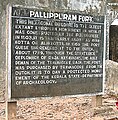Pallipuram Fort
| |||||||||||||||||||||||||||||||||
- Tips Menghapus Tato Permanen di Tubuh
- Teknik Rahasia Cara Hacker Bekerja
- Begini Cara Menghitung THR Karyawan Swasta dan Kapan Terakhir Dibayarkan?
- Perbedaan DDL Dan DML Beserta Contoh Perintahnya Dalam Database
- These are the 10 most frequently used font types in graphic design
- Apa itu Kelas Karyawan?
- Jenis-Jenis Jaringan Komputer
- Tiga Peran Penting Rumah Tangga Pemerintah dalam Kegiatan Ekonomi





